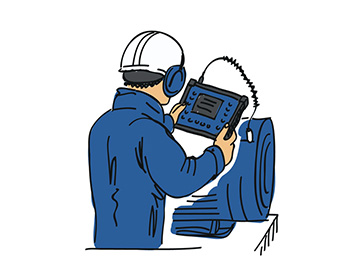What is an acceleration sensor and a vibration meter / analyzer?
Acceleration sensor - how does it work?
Imagine that your acceleration sensor is like a stethoscope which your doctor uses to listen your heart. It is basically able to monitor the vibration signal from the machine and show you the value of these vibrations on your vibration meter or analyzer.
Most commonly used acceleration sensor in industry is a piezoelectric pressure type acceleration sensor with 100 mV/g sensitivity. Maybe it sounds complicated, but not really. It is an electronic device which in very simple way looks like that inside:

Piezoelectric crystal (element) is generating the electric charge when it is deformed (compressed or stretched). To ensure deformation of the piezoelectric crystal you can see that there is some preloaded mass on it. Electric charge is transferred into the electronics of the sensor where the electric charge is coverted to Voltage. This voltage is then transferred into your vibration meter / analyzer through the sensor connector and cable.
In other words. Sensor is shaking on the running machine. Preloaded mass is deforming the piezoelectric crystal (compressing and stretching it) and this generates Voltage signal on the output of the sensor.
Vibration meter / analyzer - how does it work?
Vibration meter or analyzer is an electronic device which is able to process vibration signals. If we will take it again in very simple way, imagine that your vibration meter / analyzer is a volt meter.
The sensor is generatting Voltage signal while it is shaking on the machine. This voltage signal is transferred through the cable to your vibration device. But your vibration device will not show you volts. It is smarter that volt meter. Vibration device is able to process the voltage signal and display vibration values such as acceleration and velocity. See below chapter about the acceleration and velocity.



